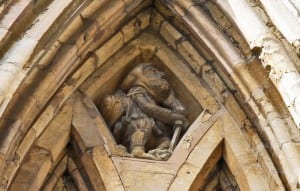Showing Conan the ideas we had for our performance piece was such an influential and important moment for us in our devising process. He was the completely outside eye that we needed, and I feel that we can now really start finalising our tour. Whilst the journey of a pilgrimage is still at the heart of our tour, we now know we need to strip back all the “extras” that we felt we needed to put in, and instead keep it to a simple but detailed audio tour of the Cathedral. As David Wiles infers, “the play-as-event belongs to the spaces, and makes the space perform as much as it makes actors perform” (Wiles, 2003, 1), which I think surmises how we need to treat our tour by letting it “perform” on its own. Knowing that we now have an aim and intention for what we want to our audience to learn and experience, our tour feels more focused. Conan also gave us some great advice on what we as the tour guides can do throughout the performance, such as one of us introducing the “rules” of the tour whilst the others can be scattered across the site to create subtle moments of interaction and coincidences for the audience as they listen. I think these moments will give our piece the playfulness that we are all keen for it, whilst letting the audio take centre stage. We can now produce and perfect our script for the audio, practice with it in the site, and decide upon those audience moments.
Wiles, D. (2003) A Short History of Western Performance Space. Cambridge: Cambridge University Press.

